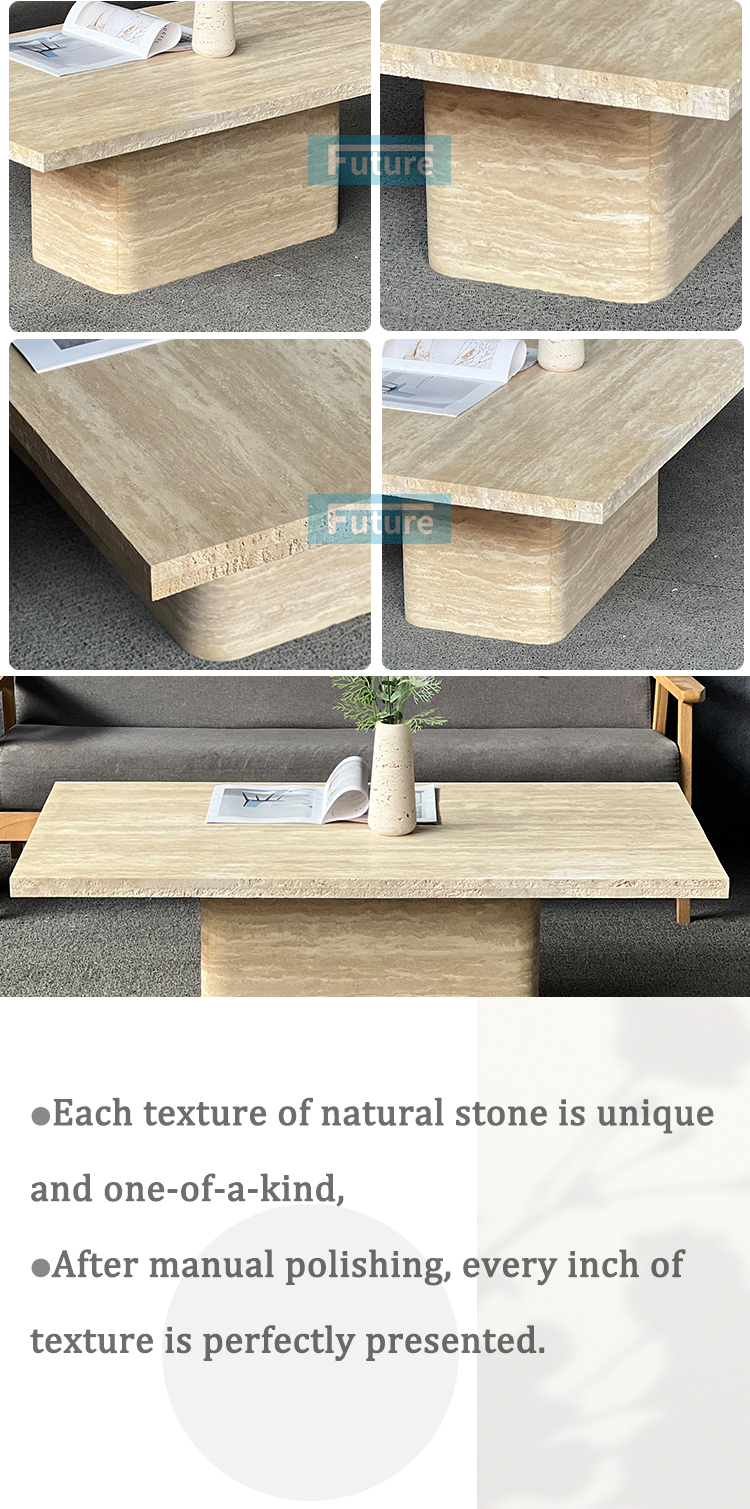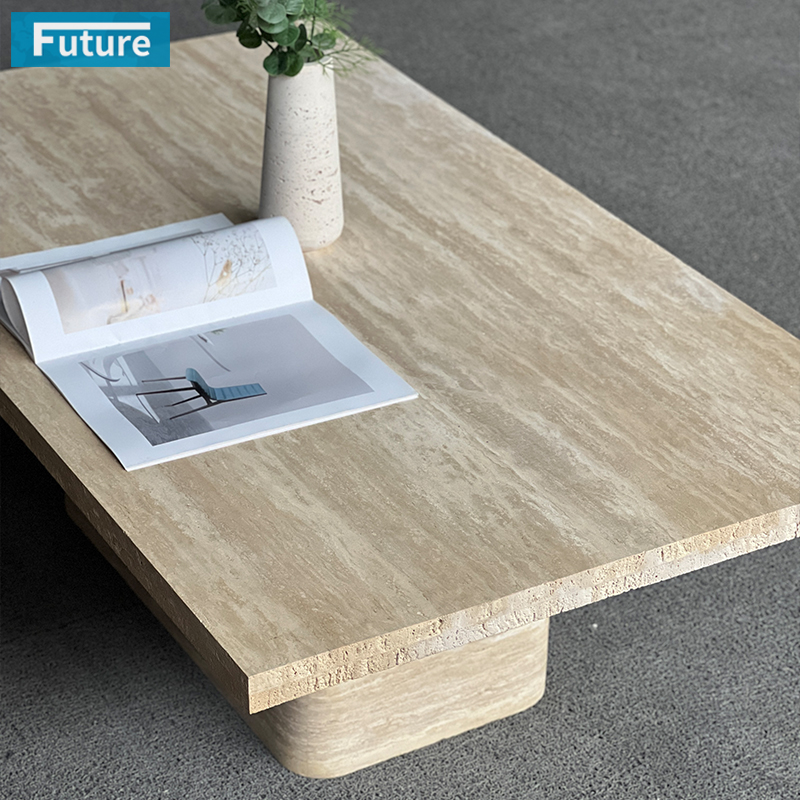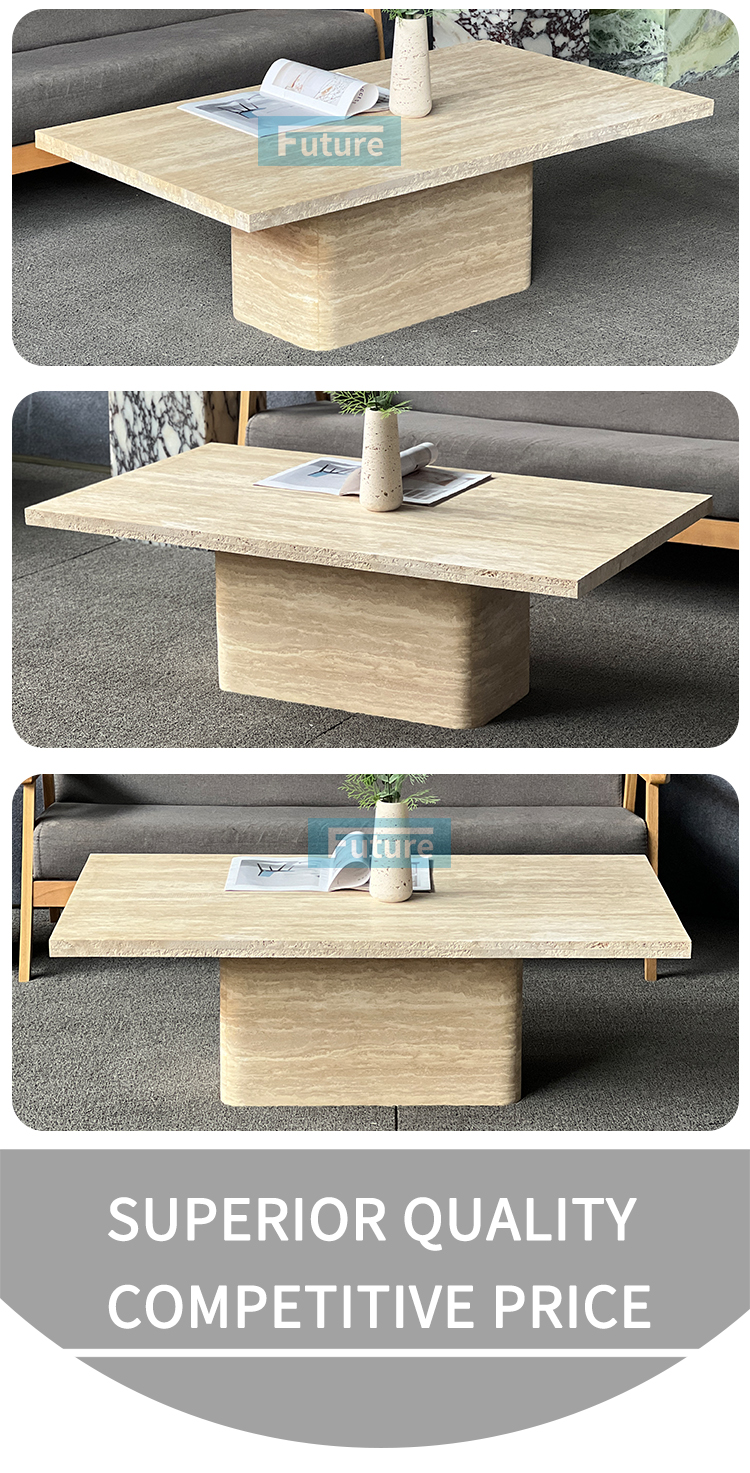Natural stone is moving beyond the dominance of classic marble, with travertine and onyx emerging as signature materials in luxury villas, hospitality projects, and high‑end residences across North America, Europe, Australia, and key emerging markets. Recent industry research estimates that the broader natural stone segment will continue to grow steadily through 2030, driven by premium housing, hotel investment, and a preference for authentic, durable materials—conditions that strongly favor distinctive stones such as travertine and onyx.
As a specialist in marble, engineered stone, and natural stone furniture, Future Stone Group is ideally placed to help architects, interior designers, contractors, and homeowners integrate these materials intelligently across flooring, cladding, and bespoke furniture. With a portfolio spanning travertine slabs, onyx slabs, marble furniture, stone countertops, and translucent backlit onyx solutions, the company operates as a technical partner rather than just a supplier, supporting both high‑end developed markets and fast‑growing Belt and Road economies.
What travertine and onyx really are
Travertine is a form of limestone deposited by mineral‑rich hot springs and rivers, characterized by visible pores and cavities created by escaping gases and evolving water channels. These pores can later be partially filled by secondary calcite, producing dense zones and banding that affect both appearance and mechanical performance.

Onyx, by contrast, is a fine‑grained banded carbonate stone—often classified commercially as a type of calcite or “onyx marble”—with a compact microcrystalline structure that allows light to pass through in a way most stones cannot. Its translucent nature and strong color banding give onyx a gem‑like presence that positions it as a semi‑precious material for high‑impact interior applications.
Technical properties of travertine
For architects and engineers, the defining characteristics of travertine are its porosity, density, and related durability. Fresh and geologically young travertines can show porosity from around 10% up to very high values, but building‑grade material for tiles and slabs more typically sits in the 8–20% range once compact facies and filled products are considered. This relatively high and variable porosity explains both the stone’s lightness and its sensitivity to moisture and staining if left unsealed.
Density for construction‑grade travertine typically falls between roughly 2.5 and 2.8 g/cm³, lower than dense marbles but sufficient for most interior and many exterior cladding and paving applications when correctly detailed. Research comparing travertine with marble confirms that marble generally presents higher density, lower porosity, and therefore higher characteristic compressive strength, while compact travertine bands can still reach strengths suitable for numerous structural and finishing uses.
Travertine’s mechanical behavior is strongly controlled by porosity and lamination: less porous cryptolaminated facies show significantly better strength, while very porous zones are weaker and more susceptible to weathering under freeze–thaw or salt crystallization cycles. For exterior work in harsh climates, this makes careful selection—favoring denser, low‑porosity travertine and robust sealing—essential to long‑term performance.
Technical properties of onyx
Onyx combines relatively high density with low open porosity in many decorative varieties, but its main engineering challenge is not porosity—it is brittleness and low hardness. With a typical hardness around 3 on the Mohs scale, onyx is softer than granite and many marbles, which makes it more prone to scratching and etching and therefore better suited to low‑traffic or protected surfaces.

A recent study on onyx‑travertine stones documented real density between 2.5 and 2.9 g/cm³ and very low open porosity (around 0.06–1.95%), with compressive strengths in the order of 60–100 MPa depending on loading orientation relative to lamination. These results show that even when porosity is modest, anisotropy and layering significantly influence strength, reinforcing the need to align slab orientation with the structural demands of facades or horizontal elements.
Because onyx is calcitic, it is also sensitive to acids and aggressive cleaning chemicals, similar to marble, which requires protective sealers and a controlled maintenance regime in kitchens, bars, and spa environments. Designers specifying onyx in performance‑critical areas often combine engineering solutions—such as composite backing and careful detailing—with operational protocols to ensure the stone’s visual quality is preserved over time.
Visual language: color, veining, and texture
Travertine typically appears in warm, desaturated palettes—cream, beige, ivory, walnut, silver, and soft grey—interrupted by veins, bands, and cloud‑like movement that reflect the layering of mineral deposits over time. Cross‑cut travertine reveals soft, mottled textures, while vein‑cut material exposes strong linear banding that resembles timber or sedimentary rock strata, giving specifiers two distinctly different aesthetics from the same quarry.

The surface finish has a major impact on how travertine reads in a space: honed and filled finishes feel refined and contemporary; brushed or tumbled finishes enhance tactile character and “wabi‑sabi” imperfection; sandblasted or bush‑hammered surfaces increase slip resistance for exterior use. This combination of neutral palettes and finish options is one reason travertine is at the center of current warm‑minimalist and biophilic design trends.
Onyx offers a completely different visual experience, with saturated whites, ambers, greens, reds, and multicolored banding arranged in semi‑transparent layers. When light passes through, these layers appear to glow from within, creating depth and movement that change with viewing angle and light intensity, which is why designers often treat a book‑matched onyx wall more like a piece of art than a standard cladding surface.
Travertine in interior architecture
In contemporary interiors, travertine is widely used for continuous flooring that runs through living areas, kitchens, and hallways, often extended onto terraces for seamless indoor–outdoor transitions. Large‑format tiles and slabs minimize grout lines and support the monolithic, gallery‑like environments favored in luxury villas and penthouse apartments in markets such as the USA, Australia, and Europe.
Travertine wall panels provide a soft, textured alternative to painted plaster or plain porcelain in feature walls, stair halls, and double‑height spaces, adding depth without overwhelming the architecture. In bathrooms, designers frequently specify honed or lightly textured travertine for floors and walls, combining it with marble or engineered stone countertops to balance warmth, performance, and cost.
Travertine outdoors: pool decks, terraces, and facades
Travertine’s moderate density and thermal behavior make it well suited to outdoor applications in warm and temperate climates when correctly detailed. Its relatively low thermal conductivity and light colors help keep surfaces cooler underfoot than many dark granites or dense porcelains, which is particularly valued around pools and in sun‑exposed courtyards.
For pool decks and patios, tumbled or sandblasted travertine pavers provide additional slip resistance while retaining a refined, natural look that integrates with landscaping. On vertical surfaces, travertine cladding can be used for ventilated facades or traditional adhesive systems, provided engineers consider anchor spacing, stone thickness, and the specific mechanical properties of the chosen quarry material.
Travertine furniture and sculptural elements
Travertine has also returned strongly in furniture and object design, reflecting a broader trend toward monolithic stone pieces in high‑end interiors. Coffee tables, dining tables, side tables, consoles, and pedestals carved from beige or white travertine bring a grounded, tactile presence that pairs well with timber, metal, and soft textiles.
For clients searching for “marble coffee table” and related keywords, designers increasingly propose travertine coffee tables or travertine dining tables as a warmer and often more budget‑friendly alternative that still communicates luxury. Combining travertine furniture with marble countertops or stone side tables from the same stone family ensures color harmony across surfaces and loose pieces, which is particularly important in open‑plan living spaces and hotel lobbies.
Onyx in interiors: from cladding to art
In interior design, onyx is typically reserved for focal elements rather than broad background coverage. It is frequently used for feature walls, fireplace surrounds, vanity fronts, and select flooring areas where its veining and translucency can be showcased without heavy wear.
Because each block of onyx is strongly individual, designers often select slabs in person and plan book‑matched or end‑matched layouts, treating the stone as an artwork that must be composed with intention. This bespoke approach is especially common in luxury residences and boutique hotels in markets like the Middle East and North America, where visual exclusivity is a key part of the value proposition.
Backlit onyx and translucent stone engineering
Backlighting is where onyx truly separates itself from other stones, turning walls, counters, and furniture into luminous features. Thanks to its crystalline structure, onyx can transmit light through slabs up to several centimeters thick, revealing internal patterns and color gradations that remain invisible under standard lighting.
The most effective technique is to mount thin onyx slabs—typically in the 10–20 mm range—on a stable backing with a uniform LED panel placed 2–4 cm behind the stone. High‑CRI LED arrays ensure faithful color rendering, while dimming and color‑tunable controls allow the lighting designer to move from cool daytime ambers to warm evening tones, effectively changing the mood without altering the stone.
Specialized lightweight systems, such as onyx veneers laminated to honeycomb panels or glass (often marketed as glass‑onyx or similar composites), reduce structural load while preserving the depth of the natural stone layer. These panels expand where backlit onyx can be used—on ceilings, sliding partitions, and large room dividers in hotels, spas, and flagship retail stores.
Real‑world design case studies with onyx
Case studies published by lighting and stone specialists demonstrate how carefully integrated backlighting can transform onyx installations. In one private residence in Palm Springs, book‑matched onyx bathroom walls were paired with color‑tunable LED panels, allowing the homeowners to highlight cool blue veining in the morning and warmer amber tones in the evening, effectively creating multiple atmospheres from a single stone selection.
Hospitality projects frequently use backlit honey or white onyx in lobbies and bar areas to create an immediate sense of arrival and luxury. A high‑end hotel bar documented by a UK stone fabricator, for example, used backlit Onice Rosa and Jade Onyx in the bar front, combining precise stonework with integrated lighting to showcase craftsmanship and color layering.
These examples underscore an important lesson for specifiers: the success of onyx is as much about lighting design, detailing, and control gear access as it is about stone selection. Early coordination between the architect, lighting consultant, stone supplier, and contractor is crucial to avoid hotspots, uneven illumination, or difficult‑to‑maintain cavities behind the stone.
Comparing travertine, onyx, and marble in practice
From a performance standpoint, travertine, onyx, and marble occupy different but complementary roles. Travertine offers a balance of elegance and practicality for floors, walls, and outdoor areas, provided porosity is managed through selection and sealing; marble provides greater robustness and familiarity for high‑traffic floors and countertops; onyx delivers strong visual drama in statement applications but requires protection and careful engineering.
Comparative studies show that typical marbles exhibit higher density, lower porosity, and higher compressive strengths than porous travertines, which explains their prevalence in heavily trafficked commercial lobbies and staircases. However, denser travertine facies and onyx‑travertine hybrids can reach mechanical performance suitable for cladding and selected load‑bearing roles, confirming that blanket assumptions about “soft” travertine or “delicate” onyx should be replaced with quarry‑specific data.
For designers, this means thinking in layers: marble or engineered stone for workhorse surfaces, travertine for warm, expansive planes, and onyx for carefully framed focal points—each chosen with a clear understanding of traffic, exposure, and required lifespan. This layered strategy is particularly effective in premium villas, hotels, and branded residences where both budget tiers and spatial hierarchy must be expressed through material choice.
Specification guidelines for travertine
When specifying travertine, start by identifying the application category: interior dry, interior wet, exterior horizontal, or exterior vertical. For interior floors and walls in dry areas, filled and honed travertine with moderate porosity is usually sufficient, backed by a robust sealing schedule and neutral‑pH cleaning products.
In wet zones such as bathrooms and spa areas, denser travertines with lower open porosity and properly filled cavities are preferable to reduce water absorption and staining risk. Non‑slip finishes—such as honed with micro‑texture, brushed, or lightly sandblasted—combined with appropriate slopes and drainage will ensure compliance with safety requirements.
For exteriors, the designer should request test data for water absorption, freeze–thaw resistance, and flexural/compressive strength, selecting facies and thicknesses that match climate and anchoring systems. Regular sealing and inspection of open joints are especially important in regions with significant temperature swings or de‑icing salt exposure.
Specification guidelines for onyx
Onyx specifications should begin with a realistic understanding of performance: this is a visually powerful but mechanically sensitive stone. It is best suited to vertical or lightly loaded surfaces—feature walls, reception desks, bar fronts, vanity fascias, decorative panels, and statement furniture—rather than hard‑working kitchen countertops or heavy‑traffic floors.
Designers should insist on structural backing solutions tailored to the installation scale: fiberglass mesh for smaller panels, honeycomb or laminated glass backing for larger spans, especially in backlit applications. Structural engineers and façade consultants should review fixing details where onyx panels form part of a building envelope or tall interior partition.
Backlighting requires technical coordination on stone thickness, LED type, distance from stone, access panels, and ventilation for drivers and power supplies. Mock‑ups are strongly recommended to fine‑tune light levels, color temperature, and diffusion layers before large‑scale fabrication, avoiding the risk of stripes, hotspots, or under‑lit zones.
Maintenance and lifecycle considerations
Travertine’s porosity demands a disciplined approach to sealing and cleaning. High‑quality penetrating sealers reduce water absorption and staining, while pH‑neutral cleaners preserve the stone’s surface and avoid etching or opening of pores.
In exterior conditions, periodic resealing and inspection for spalling, efflorescence, or joint degradation are necessary, particularly in climates with freeze–thaw cycles or airborne salts. For heavily trafficked interiors, entrance matting, appropriate chair glides, and gentle maintenance regimes extend the life of travertine floors and help them age gracefully.
Onyx maintenance focuses on preventing surface damage and protecting the stone from aggressive chemicals. Soft cloths, non‑abrasive pads, and neutral detergents are essential, while periodic resealing helps mitigate staining and moisture ingress, particularly in wet areas or near bar counters.
Backlit onyx installations also require access strategies for LED maintenance and careful heat management to avoid thermal stress on the stone and backing materials. Thoughtful detailing during design—removable panels, service hatches, and adequate ventilation—can greatly extend the lifespan of the lighting system and preserve the integrity of the stone.
Market trends: why travertine and onyx now
Design trend reports for 2024–2025 consistently highlight travertine as one of the most influential stones in residential interiors, particularly in warm, neutral schemes that reference Mediterranean and Japanese “wabi‑sabi” aesthetics. Publications aimed at architects and interior designers show widespread use of beige and grey travertines for monolithic floors, sculptural sinks, and minimalist furniture bases.
Onyx, meanwhile, has become a symbol of ultra‑luxury, especially when backlit, with design media showcasing illuminated walls, islands, and bathrooms in high‑end homes and boutique hotels. Manufacturers and specialist contractors report growing demand for translucent stone systems, leveraging improvements in LED technology and panel engineering to deliver reliable, low‑maintenance installations.
This convergence—travertine for quiet luxury and onyx for luminous drama—aligns perfectly with global market data showing strong growth in premium natural stone consumption in North America, Europe, the Middle East, and parts of Asia‑Pacific. For project teams, it offers a clear palette for differentiating spaces and price points within the same development.
How Future Stone Group adds value
Future Stone Group’s product range mirrors how leading designers are using these materials: from travertine slabs, tiles, wall panels, and engineering solutions to onyx slabs, onyx marble slabs, and translucent onyx products suitable for backlighting. The company also offers complementary categories such as marble slabs, engineered marble, quartz stone, sintered stone slabs, and stone engineering services, allowing projects to combine natural and engineered materials under a unified technical and aesthetic strategy.
For interior schemes, Future Stone Group supports complete stories—from travertine flooring and wall cladding through to marble countertops, stone wash basins, and stone furniture including marble coffee tables, stone side tables, travertine coffee tables, and travertine furniture. This integrated portfolio helps architects and designers maintain color and texture continuity across architectural surfaces and loose elements, an essential consideration in premium villas, hotels, and high‑end residential developments.
On the technical side, the company’s focus on “travertine engineering,” “stone engineering,” and “stone engineering projects” signals the ability to assist with detailing, anchoring concepts, and performance optimization, rather than simply supplying raw slabs. For onyx, expertise in “onyx backlit,” “translucent onyx stone,” and “light translucent stone backlit” positions Future Stone Group as a capable partner for complex illuminated installations that demand precise coordination between stone, structure, and lighting.
Bringing it all together
For discerning homeowners, designers, and developers, travertine and onyx are not just alternatives to marble; they are complementary materials that expand the expressive range of stone in architecture and interiors. Travertine offers warmth, tactility, and timeless calm for floors, walls, and outdoor spaces, while onyx provides luminous, art‑like focal points that define the character of key rooms and public areas.
By pairing rigorous technical understanding—of porosity, density, strength, and maintenance—with a refined design vision, project teams can leverage these stones to create spaces that feel both enduring and contemporary. With its broad material portfolio and engineering expertise across travertine, onyx, marble, and engineered stone, Future Stone Group stands ready to support that journey from concept sketch to finished surface, helping clients worldwide unlock the full beauty and performance of natural stone.



